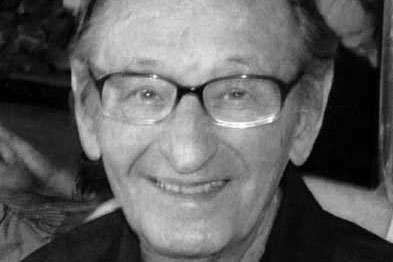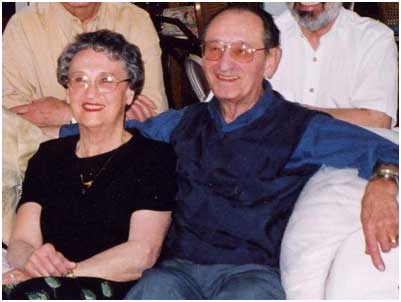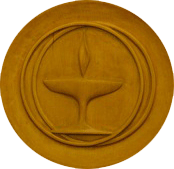
PROFILE: MORRIS SIMONS
-
Born 1920, Edmonton; died 2010, Edmonton.
-
-
In his full life, Morris built houses, sold vacuum cleaners, taught school, and sold pianos. Above all, he was a wonderful jazz pianist who delighted audiences all his life, performing until shortly before his death.
HOME / OUR HISTORY / TIMELINE / MINISTERS / PROFILES / PHOTO ALBUMS / CONTACT US
Ruth Patrick / Dorothy Keeler / Jack Ratcliff / Ada Nanning / Clarence Collins / Mary Nimmons / Phyllis Ferguson
Marion De Shield / Annabelle & Maurice Bourgoin / Frances Blythe / Bernie Keeler / Morris Simons
Helen Ready / Mary Ayres / Bill Brown
Morris Simons: Piano Man |
||
By Audrey Brooks |
||
|
(Audrey interviewed Morris while accompanying him on his last cruise, to Hawaii, in October 2010. He died shortly after returning, on Nov. 16.) Sunday, Oct. 3 “I started at a very early age,” Morris begins, with a smile and a twinkle in his eyes. He’s pleased that the Unitarian Church of Edmonton is interested in including the story of his life with those of other History Project seniors who are stalwart church members of many years standing. Morris was born in 1920 in Edmonton’s old Misericordia Hospital. He was the second in the family: Alfred (died 2003), then Morris, Harold, Sarah, and the twins, Norman and Sidney. The family lived in Round Hill, near Camrose, population 280, where their dad had a general store in partnership with a Mr. Simkin. They were the only two Jewish families in Round Hill, but Morris says he was never aware of any prejudices. When Morris was 14 and in junior high school, a travelling minister conducted Sunday services at the school: he was a charismatic Protestant who organized young guys to play baseball and did a couple of summer camps, recruiting boys, taking down age and religion information. When he came to Morris and saw that his religion was Jewish, he said: “That’s all right too!” “After a momentary reflux response to a religion he had not previously been in contact with,” says Morris, the minister was ready to field players of different faiths – Baptist, Greek Orthodox and, after a short hesitation, a Jewish boy. He went to school until Grade 11 at Round Hill, then stayed with an aunt in Legal, and took Grade 12 under Sister LaPointe. Morris says he fell in love with her, but “instead of leaving the convent and marrying me, she became Mother Superior of the convent.” Morris was 17 at this time. He used to get a ride with Father Tessier on Fridays to visit relatives in Edmonton, with good discussions on the way about philosophy and religion. Morris’s family did not practice Judaism; his father was an atheist. The family had emigrated from Russia with the name “Simovitch”, which was later changed to Simons. It was the fashion to change your name, Morris says, as foreigners were considered inferior and were denigrated. For the sake of integrating into Anglo society it made sense to change the name. This didn’t happen until he was in his 20’s, however. His dad never talked about being an atheist, but Morris figured it out once he heard his dad use the term “opiate of the masses” when referring to religion. His dad hired a teacher to teach his kids Yiddish. The Simkin and Simons kids all spoke Yiddish; their parents spoke a dialect of Russian, Ukrainian and Yiddish, mostly Yiddish, though. Morris’s dad saw the teaching of Yiddish to his children as compensation for his own rejection of the faith. Neither the Simkins nor the Simons participated in Jewish rituals after they moved to Edmonton. Morris’s mom was also Jewish, very submissive and subordinate. She did the many family tasks very well, knitting, sewing and taking excellent care of her children. They weren’t well off, so there was a lot to do. In the style of European women, his mom did not have a purse with money in it. Dad bought everything. Later in life, she occasionally did express her feelings about things, such as nearly collapsing when Morris brought his girlfriend June home and said he was going to marry her. Yet his mother more or less accepted June – and never said anything about him marrying a shiksa. This was in contrast to two of Morris’s friends who also wanted to marry shiksas, but their fathers threatened to disown them so they lived with their women, unmarried. The Great Depression hit the local economy hard. The Simons family lived in poverty. The situation became so dire that in 1932 their dad bought Simkin out; there was not enough business to support two families. Simkin had five children, Simons had six. The Simkins moved to Thorhild and bought another store, then moved on to Thorsby. When World War II began in 1939, some farmers and town folk used to come to the Simons store in the evenings to listen to the war news. Morris enlisted after he moved to Edmonton in 1939 to go to the University of Alberta in the Bachelor of Arts program, as the first step to a career in dentistry. He was in the ROTC (Royal Officers Training Corps) where he “fought out the war in Camrose,” posted there until his marriage to June on Nov. 10, 1943. He worked in the dental lab, not long enough to benefit from veterans’ pay after mustering out of the army, but he did qualify for some benefits like being able to buy a piece of property at 3% interest. After discharge from the army, he and June lived with June’s mom. He always had an interest in carving and clay modeling and in 1943, in his spare time, started carving plaster models. He got compliments from dental friends for his exceptional casting of a Norman Rockwell picture of an Army cook resting his feet with his boots off. Morris decided to pursue this art by taking a two-year pottery course in Montreal in 1947-8. Daughter Judy was born in 1947, before he took the family to Montreal. With a laugh, Morris calls himself a real “wandering Jew”. He and June had many moves, mostly in Edmonton, but they also lived in Vancouver, Victoria, Denver, Red Deer and Montreal. They moved to better themselves, and they liked a change of venue. His plan was to go into pottery in Edmonton, but it was too tough to make a living that way. Instead he went into garage building. “I didn’t have to have formal training or skills, but I had chutzpah and a bent toward construction, so I ran an ad saying I’d build garages for so much money, and gave my phone number. I did this for about two years, made a pretty good living.” Then he graduated to building eight houses in the Jasper Place area. Morris was the general contractor. Eventually Morris decided it was too hard earning a living in Edmonton. The family moved to Vancouver after Laurie was born, and bought an old three-storey house on Rupert Street, with plumbing on the outside of the house, and a pear and apple trees in the yard. “I answered an ad and became a vacuum cleaner salesman, then became a salesman for a frozen food and freezer plan that was much like the Amana Food Plan, which was prevalent at the time.” Morris was very successful at selling food and chest freezers, so much so that he sold the house on Rupert Street and bought a better one on King Edward Street. Next he took a job as sales trainer and recruiter for a vacuum cleaner company in Vancouver. For two years, Morris helped build the business. Then in 1953 business owner Duane Harvey and Morris sold their houses and moved to Denver, Colorado, where they opened a vacuum cleaner and appliance store. Laurie was two years old when they moved, and Judy six. The business was successful, but June’s father was ill and she was lonesome for Edmonton, so in 1957, right after Len was born, they came back to Edmonton. Morris opened a little piano store on 118th Avenue and 87th Street in 1957. He bought used pianos, fixed them up and sold them. He decided to expand the piano business, found a used piano dealer in Chicago and bought three truckloads of used pianos from him, then opened a new store on Jasper Avenue, on the main floor under The Steak Loft restaurant. The Unitarian Church came into the picture in 1961. The Minister was Rev. Bill Horton when Morris and June joined. They joined the small church because though they had no real religious affiliation, the kids were at an age where June and Morris decided they needed some religious exposure. Morris’s brother Hal and his wife Audrey were active Unitarians who lived close to the Hortons, and liked what the Unitarian church stood for. The family enjoyed many years with the Unitarian Church, with three generations of Simons as members. Morris was impressed with the young Bob Wrigley, minister from 1965-70, and thought he was brilliant as a speaker, and put together sermons that were masterpieces. Morris can’t remember all the UCE people who influenced their family, but he recalls these with great affection: Jack Ratcliff, Bernie and Dorothy Keeler, the Madills, Jim and Mary Campbell, the Arnasons, Jean Roth, the Evans family, Les Gue, Tig and Bill Brown, Marion De Shield, Ada Nanning, Ruth Patrick and her family, Mary and Gordon Nimmons, Phyllis Ferguson, Silver Keeping and her husband, Florence and Stan Campbell, and Bill Danyk. Morris notes that there is a memorial picture honouring the life of musician Ernie Salamandick in the church. Ernie was a sax player who played at Judy’s wedding in 1968. Ernie played sax in Morris’s band for many years. When he died, there were two services, one at a Greek Orthodox Church near Vegreville and one at the Unitarian Church with a 15-piece band led by Big Miller, provided by the Musicians’ Association. They played to a full house. Tommy Banks and all Ernie’s other musician friends were there. Daughter Laurie and Terry were married at the church in 1982. Morris said the church wasn’t just a social club, but had to act as a pro-active force with the minister a spokesman for social justice issues. Monday Oct. 4: The Musical Morris. Morris took piano lessons for only six months when he was seven years old. His first teacher died, and he had a few lessons with a new music teacher. However, the new teacher didn’t like the fact that Morris was learning popular tunes like Sweet Jennie Lee from Tennessee off the radio, and he said he was bored with what she was teaching him. She walked out, and that was the end of music lessons for him. But by the time he was 15, Morris had his own orchestra, The Katzenjammers. It was 1935-7, the big band era. One of the orchestra members was Banjo Gullackson, whose sister Audrey sang with them. Each summer at the Downtown Red Barn there was a talent show, so Morris put Audrey’s name in and she won first prize. Mark Kenny’s band heard her and hired her to tour with them, as Audrey Love. Morris says she was not a beauty, but was as good as Doris Day. Morris had his own band until he moved to Edmonton in 1940. For a few years, while at the University of Alberta, Morris played gigs at the Embers nightclub, and was relief player for Tommy Banks at The Yardbird Suite which was in a basement on Whyte Avenue. To the end of his life he was a great piano player. At the UCE annual dinner in the spring of 2010, the 90-year-old delighted the audience with his renditions of jazz standards. In the summer of 1969, Morris moved to Victoria because the previous winter had been so cold. Morris says he nearly froze to death in ’68 trying to get to his teaching job at NAIT; everything was stuck in the snow. He says that he had four good years teaching at NAIT and regrets that he left, as he could have had a good career there, with good benefits. In Victoria Morris worked as a teacher at Esquimalt School, teaching Grades 4 and 5. But the Simons came back to Edmonton because June couldn’t take the Victoria climate. In Edmonton, around 1972, he applied for a teaching job, and worked at the old Jasper Place School, then taught social studies, art and music for one year to Grade 7 and 8’s at the new Meadowlark school. He stopped teaching after 10 years including the time at NAIT. Morris then went to work for his brother Norman, a lawyer in Fort McMurray, as a development, repair and maintenance organizer and supervisor of development. Wed. Oct. 6: Retirement Morris and June spent 22 winters in Arizona from 1978 to 1999. Morris was able to buy five lots in Mesa, Arizona in a new gated trailer park as an investment, and after living there five years, bought a condo in Mesa with a nice yard. In keeping with the Simons’ usual pattern of moving, they saw another condo in Scottsdale, bought it with Judy and Peter, lived there seven years, and then bought another lot in Mesa in the Greenfields Trailer Park, because friends lived there, and they liked Mesa better than Scottsdale. After 22 winters in Arizona, June’s health brought them back to Edmonton, where June got off the plane and went to the emergency to have a pacemaker put in. They lived in Park Towers, just above fellow Unitarian Myrna Grimm, for almost 10 years, but there was only one bedroom, a small kitchen and poor laundry access. As well, Morris says that the condo board “was a pain in the ass!” Conclusion The couple made another move or maybe even more, but Morris was getting tired, and I put away my writing. He did talk about June’s death and the fact that since her death, he has no appetite or energy. He was diagnosed with terminal heart disease, but he had researched and come up with what he called “my cocktail” of herbal mixtures and salts that he claimed had helped him increase his energy and desire to get out into the world and see as much of it as he can, while he can. He said he wants to go out with a bang, not a whimper. He asked me, as the first person on his selection list, to be his travelling companion for this Hawaiian cruise, and if I couldn’t make it, I was to ask certain UCE ladies if they would like to accompany him, because, at his age, he could not travel alone. He assured me that if anything happened to him, all arrangements were made, and I was to go ahead with the rest of the holiday. On board the Zaandam, we met new friends at communal tables in the restaurants, went to musical and artistic performances, walked, sun-bathed and napped every afternoon. Morris loves people, would chat them up with humour, wit and conversation. He played jazz piano renditions in the Oceans Lounge on board, receiving enthusiastic applause from the audience, which made him grin from ear to ear.
Interviewed Oct. 3-6, 2010
© 2010 Unitarian Church of Edmonton |
||

